Everything You Need to Know About Oxygen Concentrator Use During Exercise
There is a range of severity when it comes to Chronic Obstructive Pulmonary Disease (COPD). Some patients have a severe form of COPD that requires constant use of oxygen concentrators as a part of supplemental oxygen therapy. Other patients require lesser amounts of oxygen therapy and so they may not need to reach out to their oxygen concentrator all that much. We are going to talk about the different patients suffering from COPD that are affected during exercise.
Did You Know Oxygen Desaturates During Exercise?
One of the most common complaints that we hear about in patients with COPD is that during exercise, their oxygen levels fall down below 90% SpO2. Even when a patient is normoxeamic i.e. have normal oxygen levels during rest, they develop hypoxemia during exercise.
This is a vicious cycle because some physicians make these patients reduce their exercise time. Some patients only get breathless and start coughing when they go through a high-intensity exercise routine. In such cases, the physician often asks the patients to let go of the intensive exercises.
Exercising is without a doubt a great indicator of health in patients with COPD. Even during diagnosis and treatment planning, one would find their walking time getting noted. Hence the trend of asking the patient to leave exercise is generally bad for the patient’s health.
What Can Help Improve the Exercise Time in COPD Patients?
Studies have concluded that patients with COPD can easily exercise is the perfect recipe for them is created. For every patient out there, there is a different regime that is effective. Similarly, the patients need to have different exposure to oxygen as per their body needs, not everyone is eligible for oxygen use.
Different Personalized Exercise Regimes
One of the most important findings from the study of different groups suffering from COPD undergoing strict exercise regimes is that there is always room for improvement.
- Patients who have normal amounts of oxygen during rest and lose oxygen when exercising can still exercise without oxygen. These patients can easily improve their stamina and if the trainers will it, they can progress to even more intensive exercises.
- Patients with hypoxeamia can also exercise and improve their oxygen levels during rest and exercise. With continuous exercise programs, it is effortless for patients with COPD to get into a rhythm that suits them.
Ambulatory Oxygen Therapy via Oxygen Concentrators
2 different types of COPD patient groups are consuming portable oxygen for the sake of exercising.
First Group and Oxygen Concentrator Device Use During Exercises
It has long since been practiced that patients with hypoxeamia are easily given oxygen concentrator for use during their daily life in the form of Long Term Oxygen Therapy. However, it is important to remember that such patients go through a meticulous round of testing to get their oxygen devices for personal use at home. These patients should use their oxygen devices to help better exercising experience if it’s required.
Second Group and Oxygen Concentrator Devices
Another group of patients merely gets oxygen concentrators for the sake of improving their exercise performance. These patients are the ones who start coughing during exercise and experience bouts of breathlessness. These patients believe that their stamina would get better with the use of oxygen devices while exercising. Studies have been inconclusive at best regarding these patients and the effect of oxygen therapy.
However, there is a strong suggestion from different research that pushes physicians to stop prescribing these patients oxygen devices for exercising. The studies on this topic have revealed that there is no difference in exercising capabilities with or without oxygen use. These patients can still exercise without portable oxygen concentrators to augment their exercising capabilities.
So should these patients get a prescription for ambulatory oxygen therapy?
Probably not.
If the patients don’t fall into the criteria of patients who need Long Term Oxygen Therapy, they should not be given access to ambulatory oxygen therapy easily without a rigorous amount of testing.
Exercises For COPD Patients
Research shows that the metrics for the patients exercising improved over the 8 to 12-week exercising program. The patients could eventually exercise for 40 minutes. In such a case, patients can do certain exercises with or without oxygen concentrators to support them for boosting the exercise experience.
- Patients can improve their breathing by working out with their respiratory muscles first. Practice pursed lip breathing, one nostril breathing, and deep and diaphragmatic breathing.
- Patients can then start using the treadmill and their trainer can increase or decrease their speed as per their respiratory rate. They can also walk outside if the air quality allows them.
- Cycling is another great way to improve respiratory and cardiovascular health. The patient can do it inside or outside. It is usually better to exercise inside because of the lack of exposure to smoke and other irritants.
Once the patients develop better tolerance, they will become much more active in their daily lives. The benefits of exercising are great for patients of COPD and hence the option to do so should not be ignored.
Oxygen Cylinder Prescription Recommendations for Exercising COPD Patients
Patients that do feel better with oxygen use during exercise might not necessarily need the oxygen tank that they carry around. The physician’s job is to properly test the patient’s respiratory needs so that oxygen devices are not needlessly prescribed. Exercising with oxygen concentrators should then be only for patients who benefit from it.

